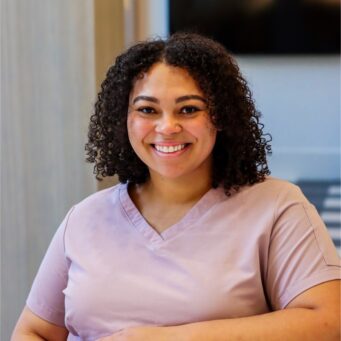
For more than 40 years, people have been building their families with the help of IVF and other assisted reproductive technologies (ART). Every year about 500,000 babies are born via IVF globally. As technology advances and becomes even more efficient and accessible, that number will grow.
I’ve been steeped in the world of reproductive health for over a decade. I pursued my bachelor’s and master’s in Gender Studies with an eager focus on women’s and reproductive health. My master’s dissertation aimed to unmask, disassemble, and analyze the worldviews and logics of ART, highlighting the inequality and viability on a global scale from an anti-racist lens.
What a privilege and pleasure it was to happily nerd out on all things repro! I trace my interests back to my mother, whose 30+ year career as a primary care physician and feminist inspired the intersection of my passions.
In recent years, I joined team pregnantish to offer my insights on the subject matter. I’ve been amazed by how much has changed in the industry since I completed my degrees just a few years ago.
The business of fertility is booming. Telehealth has arrived and is here to stay, offering access to care in a new way we’d never imagined. Investors are pouring money into the fertility industry. Scores of companies are funding new biotech innovations and technologies to advance fertility healthcare offerings around the world. I often hear from providers in our community that their businesses are bursting at the seams with demand, struggling to care for everyone in need while, still wanting to better reach those not coming through the door.
What hasn’t changed, however, is that the majority of those who need help building their families do not have access to fertility medicine or treatments, largely stemming from financial or geographic constraints.
As the industry grows and demand for care increases, it’s clear that the future of fertility rests heavily on the need for better technology that can expand access and lower costs. As the industry grows and demand for care increases, it’s clear that the future of fertility rests heavily on the need for better technology that can expand access and lower costs.
I believe that there is an art to ART. It’s hard for me to ever imagine or want a world in which the rockstar humans in the lab are replaced solely by tech and bots. What I do wish for, however, is a world in which technological advancements enhance the work of our physicians and lab staff – not replace it.
How can technology power the next generation of families created via ART? How can automation create better efficiencies and fewer errors? What enhanced systems can we dream of that will support clinicians to do their work even better and reach more people? Where are we now in that journey? What is the future of fertility?
To get a clearer picture of the fertility landscape, I connected with experts and thought leaders in ART – a current Endocrinologist, an OBGYN and REI, an entrepreneur and healthcare investor, and the founder of pregnantish. No one can predict what the meeting of opportunity and ingenuity will create, but these insiders share insights that will help us navigate the present and future of this industry.
IVG, Robotic Surrogacy, and 3-Parent IVF
How futuristic are we already?
Today’s headlines read increasingly like a sci-fi novel. Last month alone I saw two spotlights on major ART breakthroughs. First, a baby in the UK was born with DNA from three people after a new IVF procedure was approved. Second, there was a hefty spotlight on the Japanese inventors of in-vitro gametogenesis, or IVG — the production of gametes outside the body, beginning with non-reproductive cells — which was proved possible in mice. Researchers took skin cells from a mouse’s tail and transformed them into egg cells. Once fertilized, the eggs were transferred to the uteruses of mice, who birthed ten pups.
Scientists are chipping away at a one-stop-shop future of fertility where sex isn’t needed to make a baby. Many experts in the biotech world are focused on automating one piece of that gestation process at time – i.e., using AI and robotics to inject sperm, freeze eggs, nurture embryos, etc. – to make IVF less expensive and more widely accessible.
For example, the first babies conceived with a sperm-injecting robot were born. The company that developed the robot, Overture Life, believes the device is an initial step toward automating IVF, and potentially making the treatment less expensive and far more accessible than it is today.
While the buzz is loud and the tech is undoubtedly impressive, these inventions are a long way from standard procedure for most patients and providers. In 2023, it still takes a village to create a baby via ART and there are numerous hands that touch the process. But what if every IVF clinic had a sperm-injecting robot? What would the future of care look like? Might this type of automation enable providers to effectively and efficiently care for more patients?
A Futurist and Investor’s Perspective on the Growing Industry

Dr. Sable – an entrepreneur, healthcare investor and former practicing REI – has been thinking about this a lot
Dr. Sable says, “If you go back to the very beginning, IVF had a decade or two where no one really expected it to work. It wasn’t until the 1990s where we had a decent shot at getting [patients] pregnant… Now, with the best clinics, they’re reaching well over 50% or 60% success rates per single embryo. We’re at a point where we’re giving people a really targeted solution to their problem. The efficiency of doing IVF is so much higher, so now we really need to address making it available to everyone. Now, with the best clinics, they’re reaching well over 50% or 60% success rates per single embryo. We’re at a point where we’re giving people a really targeted solution to their problem. The efficiency of doing IVF is so much higher, so now we really need to address making it available to everyone.
“Outcomes should be the same no matter where you go. We now have a way to pick apart the artisanal process that is IVF and make it into something standardized. First, it should be accessible [geographically] wherever you are and second, outcomes should be predictable and uniformly good. We need to move to a marketplace in which IVF is a purchasing decision where you’re not squandering your financial stability and future for the sake of having a child…Even if it were free, putting yourself through the current process of IVF with the chance of getting nothing from it is a lot to ask. Plus, writing a check for $15-20,000 and having nothing to say for it? No wonder people stay on the sidelines.
“We will get there, and it’s frustrating we won’t get there fast enough to help everyone now. It pained me when I saw IVF patients for over 20 years – I knew we would be working on things that couldn’t help my struggling patients immediately. It still keeps me up at night.”
What’s New in the Lab? Alease the Embryologist Weighs In

Alease Barnes, known by many on social media as @AleaseTheEmbryologist, is a Senior Embryologist based in North Carolina. She shares the lived experiences of those with their boots on the ground, doing the important lab work to help people create their families with ART.
Barnes explains, “As an embryologist, I spend most of my time in the lab of IVF clinics. My job is to create embryos, whether through culturing, freezing, or thawing them, doing biopsies for genetic testing, or embryo transfer for patients. I do the behind the scenes lab work.”
When it comes to the newest and flashiest technological advancements in ART, Barnes shares her admiration, perspective, and concern: “I think we’ll start to see more pieces of technology that aid us and help us with, say, sperm or embryo selection, but I don’t think in my lifetime I will see a whole robot doing ICSI. There will be a lot of tech to aid us in what we already do, but I think it’s far off to think that we’ll have a robot that can do ICSI or a biopsy in every lab.
“In my experience, I think some of these things can benefit patient outcomes, but I think they are a long way from being implemented. These are very expensive pieces of equipment, sometimes costing hundreds of thousands more than the annual salary of an embryologist. Clinics would rather hire an embyrologist, which is cheaper, so in the short-run, this tech makes things more expensive. It might cost $500,000 to $1 million dollars for one piece of equipment! At that rate, a clinic is able to hire 9 or 10 embryologists instead. So when you purchase that kind of equipment, the cost does get passed down to the patient. That’s why while the research can come out quickly, it can be slow to actually be implemented into the lab itself.”
While she’s not seeing robots in her lab currently, Barnes does note major – though less flashy – improvements that she’s witnessed over the years as an embryologist. I’ve seen lots of changes in the field – the biggest one being genetic testing for embryos. It’s become much more widely used and accepted, as well as much more accurate. We can test for a lot more things now than we used to.
She says, “I’ve seen lots of changes in the field – the biggest one being genetic testing for embryos. It’s become much more widely used and accepted, as well as much more accurate. We can test for a lot more things now than we used to. We can test for genetic abnormalities, or inherited genetic disorders like sickle cell anemia, or Huntington’s, because often patients have concerns about passing down [problematic] genetics to their embryos. Technology has improved. I see better techniques and better equipment that make our lives easier and are making patient outcomes better.”
Barnes also notes observing vast improvements in embryo selection via AI software, tank monitoring and maintenance, non-invasive PGT, cryo-protectant media, storage units for tanks, alarms for tanks, and different ways to ensure embryos don’t get mixed up.
She shares: “This is technology we’re using now that isn’t necessarily going to culture embryos, but it is enhancing parts of the lab process. For example, we now have better incubators and cryo-devices which are fairly inexpensive compared to past technology, but the payout for this upgrade is huge. In the 1990’s, we did slow frozen embryos and survival rates were bad, and 60% of embryos were not surviving. But with cryoprotectant and vitrification getting better, our warming success rates are upward of 97% for most practices. Those practices cost almost the same, but the tech improvements gave us a big payout. Ultimately, that’s better for patients and saves us so much time. We always have to validate the point of differentiation to see if it’s worth it to buy the equipment. There has to be enough research to show it improves outcomes, and is replicable and verified.
“Another example is non-invasive PGT testing. Currently with traditional biopsy, we take 5-10 cells from the embryo and send them for testing. A few companies are researching and bringing to the US a technology where instead of physically sending cells, we are sending the embryo’s media. The embryo sheds DNA that is growing and we can send that media instead. This is far less invasive and much safer for the embryos, which then betters the outcomes for patients.”
Barnes is also highly concerned about access, and the difficulty so many face when seeking care. She says: “Those in rural areas that don’t have clinics local to them that have to travel to a practice are far less likely to get care and are often left out. Historically people of color have also had a hard time accessing care. Even though they have the same rates of infertility as white people, we don’t see people of color getting the care they need, often due to mistrust in the medical system from a long history of racial bias. Patients who don’t have insurance are also left out of this care, as many states do not cover infertility. So patients pay out of pocket, and it’s expensive and they can’t afford it. Or, they’ll spend a decade saving up but then they’re too old to get the care they’d saved up for. Insurance coverage would allow accessibility to more patients.”
Barnes concludes, “There will come a time where patients have to make a choice – ‘Do I want a person in there, or do I want to rely on tech to do this for me?’ and I think many will prefer the risk of human error because ultimately it’s a human process. Even though we’re doing it in a lab, that human element is still there with us.”
Why the Patient-Provider Relationship is Connected to the Future of Patient Care

Pregnantish has been a leader in identifying infertility issues and opportunities since it began and founder Andrea Syrtash is a prominent thought-leader in the category.
Pregnantish started as a first-t0-market media platform that inspired, educated, and connected the millions of people who aim to start their families with “a little help.” While pregnantish continues to grow its content, audience, and commitment to de-stigmatizing infertility every day, there’s even more happening behind the scenes at pregnantish.
It has grown to include a division focusing on research and thought leadership, called Pregnantish Insights. Pregnantish Insights is dedicated to improving outcomes on all sides of the patient-provider relationship equation. Through this initiative, Pregnantish sourced and scientifically-published one of the largest studies ever on why patients leave their fertility clinics, and has brought its learnings to global conferences in the US and Europe, trended in Brazil, and is currently expanding its global reach.
Pregnantish’s next phase of thought leadership is laser-focused on identifying solutions to bridge the gap between patients and providers, with the recognition and belief that patient care and provider burnout are deeply connected. In the summer of 2023, Pregnantish is launching its next study with further research on patient pain points. The study aims to identify how our industry can better serve and communicate with patients to achieve their desired results.
As a platform that works with both patients and their healthcare specialists, pregnantish is uniquely positioned to help bridge the gap between them and enable both sides to communicate better to achieve their shared goal: a healthy baby. Perhaps it’s no surprise that pregnantish would take this approach considering that its founder, Andrea Syrtash, was a long-time fertility treatment patient and is also a nationally recognized relationship expert and prolific published author. I asked Andrea to weigh in on where she views the future of care is going.
Syrtash says: “Today, the demand for care is high and access is a challenge that is burning us all out. The cost and the lack of providers available to handle the volume of need is prohibitive for patients. Providers can’t keep up. There’s pain for the patient who already has had a difficult process and experience, which is made more painful when clinics can’t serve them properly with the right care, attention to detail, and the individualized approach they desire. We know that what patients want is what every person wants – to be seen, heard, and valued. If you’re in a busy center that is overbooked, you don’t always get that quality of care or customized approach. Sometimes you feel like you’re just a number. When the feeling is that a center is transactional and not relational, relationships break down. And our data at pregnantish shows this.”
Ultimately, pregnantish is working to advocate for all stakeholders in the process of ART since everyone wants the successful outcome of a baby. We’ve never made a baby with just one person – so we can’t only look at one side of the equation if we want to improve this experience! There are so many people involved – doctors, nurses, embryologists, lab techs, pharmacists. We’re all on the same team… So it’s important for us to reduce pain points on both the patient and provider side…
Syrtash continues, “At pregnantish, we are focused on improving this relationship so that patients don’t hop around so much because they don’t feel taken care of at their clinic. We want to help the patients feel more supported and we want to help support our friends who are doctors, nurses and embryologists, too, as they are doing important work and oftentimes are also burnt out with the demand.
“We’ve never made a baby with just one person – so we can’t only look at one side of the equation if we want to improve this experience! There are so many people involved – doctors, nurses, embryologists, lab techs, pharmacists. We’re all on the same team, even though we’re working separately. So it’s important for us to reduce pain points on both the patient and provider side, and ultimately to work together. A happy provider creates a happier patient, and vice versa. Our work in this next phase is to bridge that gap.
Our Fertility Doctors Share Our Dream — And They Also Need Support

Dr. Lucky Sekhon, OBGYN and REI at RMA of New York, shares her perspective as a provider that has experienced pregnantish’s programming firsthand. She says: “The field of fertility medicine has been revolutionized with improved lab technology and testing, allowing for much higher success rates and more options for patients. As we continue to try and improve outcomes for our patients, we are also realizing the need for support for their mental health and to find ways to promote resilience. Patients dropping out of their clinic or treatment prematurely due to feeling burnt out is a significant issue. As we continue to try and improve outcomes for our patients, we are also realizing the need for support for their mental health and to find ways to promote resilience.
“Clinics are now focusing on taking a more multidisciplinary approach to make patients feel more supported and less inclined to drop out. The doctor-patient relationship is of utmost importance. Open, clear communication and compassion is key. A key element in fostering this is preventing physician burnout and addressing pain points in the clinic. Pregnantish is doing amazing work in this area – speaking to patients and physicians to better understand the issues they face on both sides – in order to help us overhaul our current systems and to improve the patient experience.”
What Can We Expect Next?
The future of fertility is far from predictable, seemingly limited only by imagination. There are loads of speculative technologies on the horizon that get even more stranger than fiction by the day. (Even artificial wombs, with embryos gestating in scientific centers until birth). While the upcoming technological advancements are unclear, they’re bound to start out grand and very expensive.
What is critical is that the next phase of the industry be focused on broader access to ART and on the humans involved in the process.
Even smaller enhancements to automation could enable doctors to precisely measure their work, allowing them to fine-tune their procedures. A “small” increase in success rates could mean tens of thousands more families reached and babies born every year.
Futurist and fertility sector investor Dr. Sable concludes, “It’s been 40 years of fabulous science and lousy engineering. Access has always been an issue, and now it’s a pressing issue. And it’s never been more attainable. We can start modeling what works and what doesn’t. There are no excuses anymore. The time is now to create a best practices model and reach anyone who has been sitting on the sidelines.”
Contributor
Carolyn Kossow
Carolyn Kossow (she/her) is a gender, queer, and racial justice communications professional and activist based in Brooklyn, NY. She received both her Masters and Bachelors degrees in Gender Studies (London School of Economics and Hamilton College, respectively) with a focus on reproductive health, and is dedicated to a life and career advocating for social justice. Carolyn supports the work of pregnantish through subject matter expertise, content creation, and project management. Carolyn’s work and research has utilized critical-race, queer, and feminist theories to examine reproductive health injustices worldwide with specific focus on racism and classism within assisted reproductive technologies (i.e., egg donation and surrogacy). She has worked in several nonprofits and start-ups advocating for economic, racial, LGBTQ, and gender justice at a local and global scale.

Listen to stories, share your own, and get feedback from the community.


















